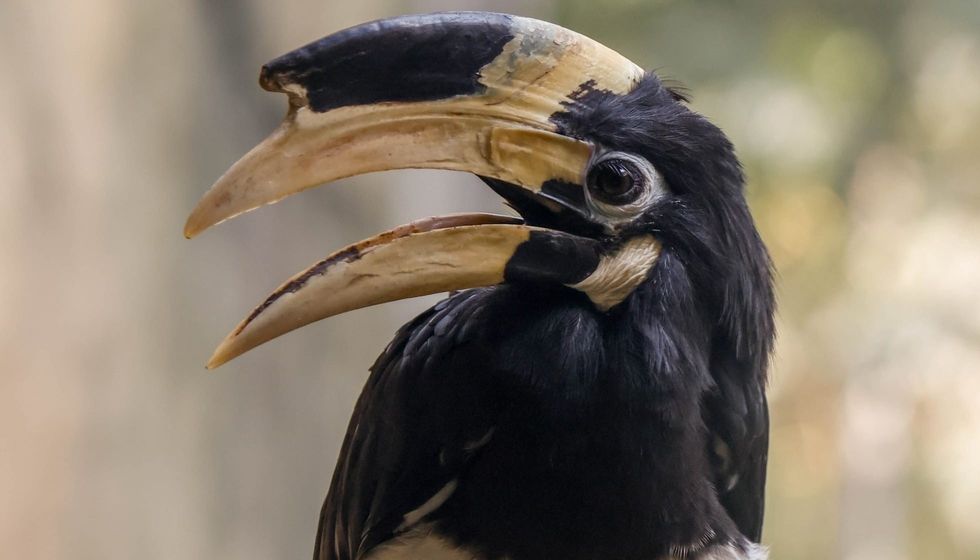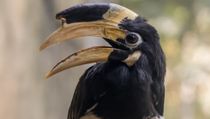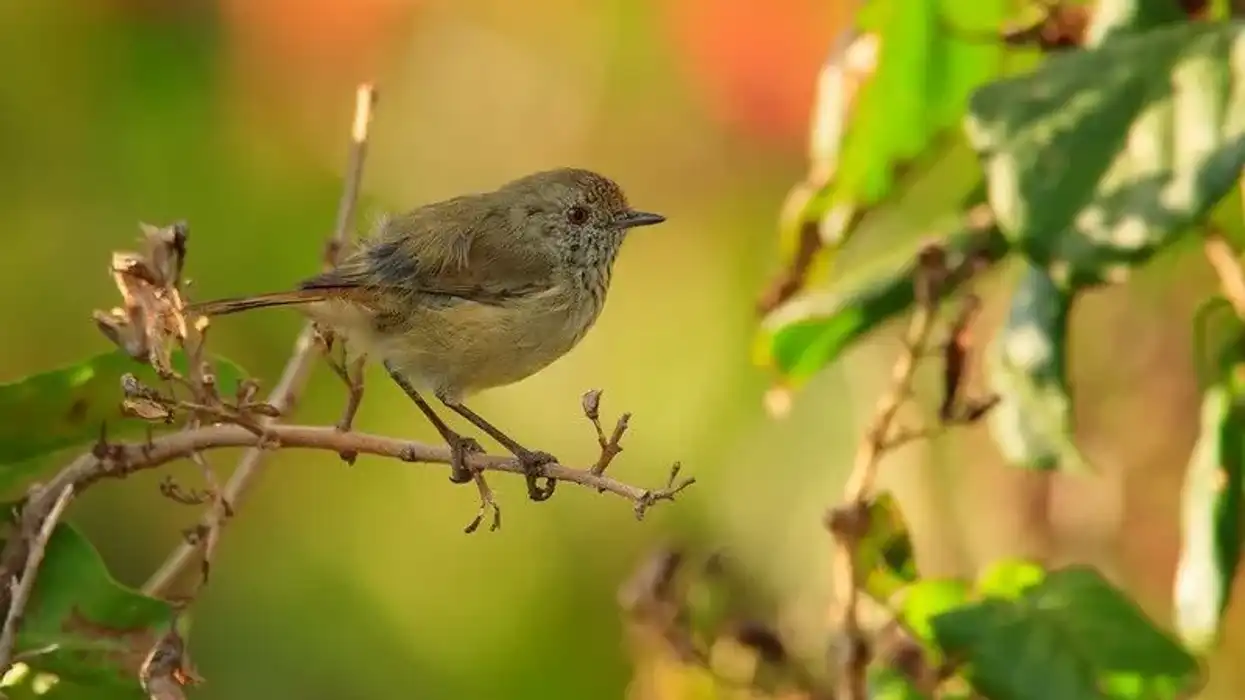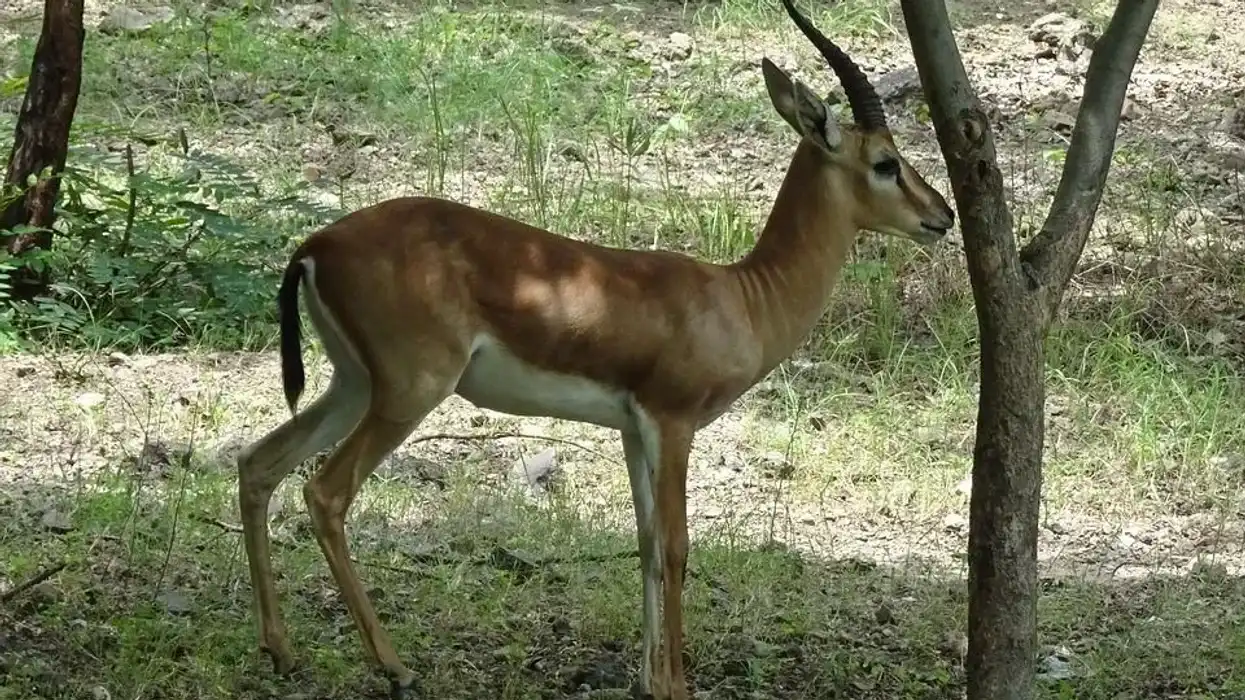The Malabar pied hornbill (Anthracoceros coronatus), also known by the name of the lesser-pied hornbill, is a type of bird from the family of hornbills. The bird belongs to the Old World species.
The Malabar-pied hornbill was first described in the year 1780 by the French polymath, Georges-Louis LeClerc, Comte de Buffon in his book. It was also illustrated in many other records by several naturalists and bird-enthusiasts.
The species is monotypic in nature whose generic name is made up of the ancient Greek word 'anthrax', meaning coal-black, and 'keros', which stands for horn. The specific epithet 'coronatus' is a Latin word, meaning crown.
The bird is a large bird that can grow up to a length of 26 in (65 cm), mainly consisting of black feathers on its belly, throat, and tail apart from its white abdomen. The other most distinct feature of the bird is its large bill is yellow with an extra black casque just above it.
Females have a white orbital coat. The bird is typically found in the Indian subcontinent along with Sri Lanka in the evergreen forest habitats of the region and also near human settlements.
The birds are omnivorous in nature and eat a variety of things from fruits to small mammals and even insects.
They are very fond of figs and are frequently spotted in the Karwar region. According to the central tribal people of India, hanging the skull of the Malabar-pied hornbill brings wealth, due to which the bird has been hunted for centuries.
Do check out our rhinoceros hornbill facts and great hornbill facts pages for more similar content.
Malabar Pied Hornbill Interesting Facts
What type of animal is a Malabar pied hornbill?
The Malabar pied hornbill (Anthracoceros coronatus) is a type of bird from the family of Bucerotidae under the animal kingdom.
What class of animal does a Malabar pied hornbill belong to?
The Malabar pied hornbill (Anthracoceros coronatus) belongs to the Aves class of animals from the genus Anthracoceros under the family of Bucerotidae from the animal kingdom.
How many Malabar pied hornbills are there in the world?
The estimated numbers for the Malabar pied hornbill's population count is unknown but it is assumed that they have a moderate to a small sized population. This is a result of the consistent decline in its population trend, due to habitat loss and poaching.
Where does a Malabar pied hornbill live?
The Malabar pied hornbill (Anthracoceros coronatus) is endemic to the Indian subcontinent and is a common sight in India and Sri Lanka. The birds are mostly found in the tropical regions of the countries or near suburban areas.
What is a Malabar pied hornbill's habitat?
The hornbill is a common resident breeder in southern Asia, found around the tropical regions of India, Sri Lanka, and East to Borneo. The bird's preferred habitat includes the Western Ghats, Central Indian forests, and Sri Lanka.
There have also been reports of bird sightings in the regions of Satpura and Karwar.
They are found in open woodlands, deciduous forests, evergreen forests, plantations, cultivating areas, and suburban human settlements. A population of them is scattered around the little island of the Kali backwaters or in the Dandeli Wildlife Sanctuary perched on top of tree canopies and on the ground looking for food.
Who do Malabar pied hornbills live with?
The birds move around in small groups usually consisting of 10 birds but sometimes prefer gathering in large groups, 10 times their usual size. At other times in the Dandeli Wildlife Sanctuary, there have been reports of flocks of hundreds of hornbills regularly visiting fruit trees together and occasionally coming to the ground for a dust bath.
How long does a Malabar pied hornbill live?
Hornbills live for a long time. The average life expectancy of the species is about 50 years if kept in captivity but now faces a Near Threatened status of extinction.
How do they reproduce?
The birds are sexually dimorphic and find incredible habitats during the breeding season where they nest in the natural cavities of an old tree hole. These trees must be 13.12-49.21 ft (4-15 m) above ground.
An important ritual that is showcased during their courtship is how the male bird brings the female small gifts of mud balls to have her attention.
The breeding season begins in March-April where the female usually seals herself into the tree hole by blocking the entrance with the help of pulp, mulch, or saliva and incubates her eggs in there for a month where she lays about two to five eggs and waits for the first chick to hatch.
The male, during this time, brings her food and looks after the nest from the outside. The female comes out of her nest only after their oldest chick is about three to four weeks old, after which both the pair feed the chicks together.
The chicks stay inside the cavity for a few more weeks until they are ready to finally be independent and fly.
What is their conservation status?
The conservation status of the Malabar pied hornbills is Near threatened, similar to other Western Ghat species who face an extreme threat of encroachment and habitat loss. In an attempt to save the species for India's bird footprint as the hornbill is a common resident breeder.
Malabar Pied Hornbill Fun Facts
What do Malabar pied hornbills look like?

The Malabar pied hornbills are large-sized birds that can grow up to a length of 26 in (65 cm). The bird has a black plumage but a white belly.
Its belly, throat patch, tail sides, and the trailing edge to its wings are all black apart from its white underwings while its bill is yellow in color.
The upper casque, right above its bill, is black. Unlike the male birds, females have a white orbital skin which the males lack in their appearance and as for the juvenile birds, they do not possess any casque above their bill which might be somehow confused with the Oriental pied hornbill as they look similar.
How cute are they?
The Malabar pied hornbill is not that cute if compared to other cuter species like hamsters, but do possess their own charm and cute behavioral habits. Especially their mating rituals which are no less than adorable. They are also one of the many species of animals that mate for life.
How do they communicate?
The birds communicate to one another vocally. They have various loud calls, particularly a raucous cackle that consists of a kleng-keng or kak-kak sound. The same is usually followed by loud squeals.
How big is a Malabar pied hornbill?
The average length of a Malabar pied hornbill is estimated to be about 26 in (65 cm).
How fast can a Malabar pied hornbill fly?
The average estimation regarding a hornbill's speed of flight is 18 mph (28.96 kph) so, we can assume that the Malabar pied hornbill flies within this range of speed.
How much does a Malabar pied hornbill weigh?
A Malabar pied hornbill has an average weight of 2.20 lb (1 kg).
What are the male and female names of the species?
There are no specific names given to the species according to their sex.
What would you call a baby Malabar pied hornbill?
A baby Malabar pied hornbill is called a chick.
What do they eat?
These birds are omnivorous in nature and can eat both fruits and other small animals. Their diet usually consists of fruits, fish, small mammals, like rats and rodents, insects like grasshoppers, seeds, reptiles like golden tree snakes, sand lizards, and other similar vertebrates.
One peculiar habit of the bird includes the consumption of strychnine, which is a toxic fruit for many vertebrates but the hornbills eat it with ease and excrete out their poisonous seed. The birds usually swallow their prey whole.
Are they dangerous?
No, these birds are not dangerous unless provoked. They are usually very shy and do not like being watched.
Would they make a good pet?
No, hornbills are very loud and do not do well in confined spaces. They love being free like all the other birds in the wild and prefer being left alone. As such, they would not make a good pet as they are wild animals and belong in the jungle.
Did you know...
The Malabar pied hornbill is migratory in nature but does not migrate outside the country, which makes them a local migratory bird species. They migrate to warmer states, like Goa, and similar other forested areas of the country whenever the winter season arrives.
Which is the largest hornbill in India?
The largest hornbill found in India is the great hornbill (Buceros bicornis), also known as the concave-casqued hornbill or the great pied hornbill, with a length of 44.09-58 in (112-150 cm) and weighing about 4.62-8.59 lb (2.1-3.9 kg). The bird is found in the forests of the northeastern regions, Western Ghats, and around the Himalayas.
Do hornbills drink water?
Interestingly, hornbills do not drink water directly from a water source. They obtain water from their diet of fruits, so there is no need for them to drink water directly from a water source.
All they have to do is eat fruits and gain their water supplements. The birds would hunt their prey and swallow them whole instead of breaking it down, and later on, consume a lot of fruit for their need of water.
Here at Kidadl, we have carefully created lots of interesting family-friendly animal facts for everyone to discover! Learn more about some other birds including azure-winged magpie facts and red-tailed hawk interesting facts for kids.
You can even occupy yourself at home by coloring in one of our free printable Malabar pied hornbill coloring pages.
Main image by Phadke09.
Second image by Rohitjahnavi.









